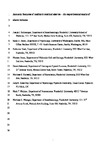Acoustic features of auditory medical alarms - an experimental study of alarm volume
| dc.contributor.author | Schlesinger,, JJ | |
| dc.contributor.author | Baum, SH | |
| dc.contributor.author | Nash, K | |
| dc.contributor.author | Bruce, M | |
| dc.contributor.author | Ashmead, D | |
| dc.contributor.author | Shotwell, MS | |
| dc.contributor.author | Wallace, MT | |
| dc.contributor.author | Weinger, MB | |
| dc.contributor.author | Edworthy, Judy | |
| dc.date.accessioned | 2018-06-08T16:12:29Z | |
| dc.date.issued | 2018-06-01 | |
| dc.identifier.issn | 0001-4966 | |
| dc.identifier.issn | 1520-8524 | |
| dc.identifier.uri | http://hdl.handle.net/10026.1/11630 | |
| dc.description.abstract |
<jats:p>Audible alarms are a ubiquitous feature of all high-paced, high-risk domains such as aviation and nuclear power where operators control complex systems. In such settings, a missed alarm can have disastrous consequences. It is conventional wisdom that for alarms to be heard, “louder is better,” so that alarm levels in operational environments routinely exceed ambient noise levels. Through a robust experimental paradigm in an anechoic environment to study human response to audible alerting stimuli in a cognitively demanding setting, akin to high-tempo and high-risk domains, clinician participants responded to patient crises while concurrently completing an auditory speech intelligibility and visual vigilance distracting task as the level of alarms were varied as a signal-to-noise ratio above and below hospital background noise. There was little difference in performance on the primary task when the alarm sound was −11 dB below background noise as compared with +4 dB above background noise—a typical real-world situation. Concurrent presentation of the secondary auditory speech intelligibility task significantly degraded performance. Operator performance can be maintained with alarms that are softer than background noise. These findings have widespread implications for the design and implementation of alarms across all high-consequence settings.</jats:p> | |
| dc.format.extent | 3688-3697 | |
| dc.format.medium | ||
| dc.language | en | |
| dc.language.iso | en | |
| dc.publisher | Acoustical Society of America | |
| dc.subject | Acoustic Stimulation | |
| dc.subject | Acoustics | |
| dc.subject | Adult | |
| dc.subject | Auditory Threshold | |
| dc.subject | Clinical Alarms | |
| dc.subject | Female | |
| dc.subject | Humans | |
| dc.subject | Loudness Perception | |
| dc.subject | Male | |
| dc.subject | Middle Aged | |
| dc.subject | Noise | |
| dc.subject | Perceptual Masking | |
| dc.subject | Physicians | |
| dc.subject | Signal Processing, Computer-Assisted | |
| dc.subject | Sound Spectrography | |
| dc.subject | Speech Acoustics | |
| dc.subject | Speech Intelligibility | |
| dc.subject | Task Performance and Analysis | |
| dc.subject | Visual Perception | |
| dc.subject | Voice Quality | |
| dc.title | Acoustic features of auditory medical alarms - an experimental study of alarm volume | |
| dc.type | journal-article | |
| dc.type | Journal Article | |
| dc.type | Research Support, N.I.H., Extramural | |
| dc.type | Research Support, Non-U.S. Gov't | |
| plymouth.author-url | https://www.ncbi.nlm.nih.gov/pubmed/29960450 | |
| plymouth.issue | 6 | |
| plymouth.volume | 143 | |
| plymouth.publication-status | Published | |
| plymouth.journal | Journal of the Acoustical Society of America | |
| dc.identifier.doi | 10.1121/1.5043396 | |
| plymouth.organisational-group | /Plymouth | |
| plymouth.organisational-group | /Plymouth/Faculty of Health | |
| plymouth.organisational-group | /Plymouth/Research Groups | |
| plymouth.organisational-group | /Plymouth/Research Groups/Centre for Brain, Cognition and Behaviour (CBCB) | |
| plymouth.organisational-group | /Plymouth/Research Groups/Centre for Brain, Cognition and Behaviour (CBCB)/Behaviour | |
| plymouth.organisational-group | /Plymouth/Users by role | |
| dc.publisher.place | United States | |
| dcterms.dateAccepted | 2018-06-04 | |
| dc.rights.embargodate | 2018-12-27 | |
| dc.identifier.eissn | 1520-8524 | |
| dc.rights.embargoperiod | No embargo | |
| rioxxterms.versionofrecord | 10.1121/1.5043396 | |
| rioxxterms.licenseref.uri | http://www.rioxx.net/licenses/all-rights-reserved | |
| rioxxterms.type | Journal Article/Review |


